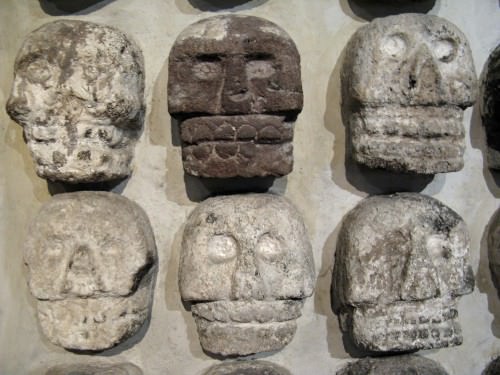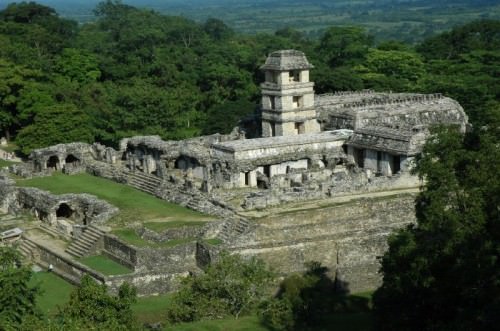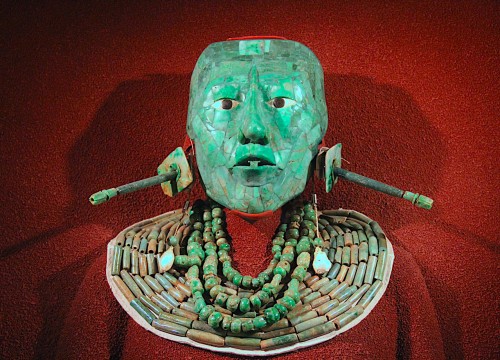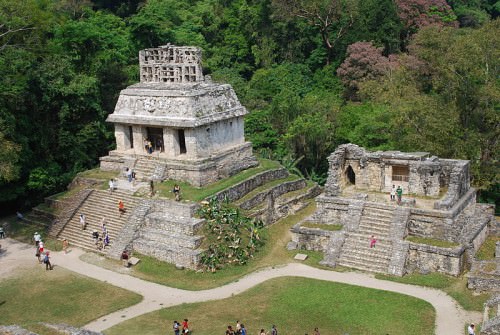Aztec Sacrifice › Palenque » Ancient origins
Articles and Definitions › Contents
- Aztec Sacrifice › Ancient History
- Palenque › Antique Origins
Ancient civilizations › Historical and archaeological sites
Aztec Sacrifice › Ancient History
Definition and Origins

The religion of the Aztec civilization which flourished in ancient Mesoamerica (1345-1521 CE) has gained an infamous reputation for bloodthirsty human sacrifice with lurid tales of the beating heart being ripped from the still-conscious victim, decapitation, skinning and dismemberment. All of these things did happen but it is important to remember that for the Aztecs the act of sacrifice - of which human sacrifice was only a part - was a strictly ritualised process which gave the highest possible honour to the gods and was regarded as a necessity to ensure mankind's continued prosperity.
ORIGINS & PURPOSE
The Aztecs were not the first civilization in Mesoamerica to practise human sacrifice as probably it was the Olmec civilization (1200-300 BCE) which first began such rituals atop their sacred pyramids. Other civilizations such as the Mayaand Toltecs continued the practice. The Aztecs did, however, take sacrifice to an unprecedented scale, although that scale was undoubtedly exaggerated by early chroniclers during the Spanish Conquest, probably to vindicate the Spaniards own brutal treatment of the indigenous peoples. Nevertheless, it is thought that hundreds, perhaps even thousands, of victims were sacrificed each year at the great Aztec religious sites and it cannot be denied that there would also have been a useful secondary effect of intimidation on visiting ambassadors and the populace in general.
IN ANCIENT MESOAMERICA HUMAN SACRIFICES WERE VIEWED AS A REPAYMENT FOR THE SACRIFICES THE GODS HAD THEMSELVES MADE IN CREATING THE WORLD.
In Mesoamerican culture human sacrifices were viewed as a repayment for the sacrifices the gods had themselves made in creating the world and the sun. This idea of repayment was especially true regarding the myth of the reptilian monster Cipactli (or Tlaltecuhtli ). The great gods Quetzalcoatl and Tezcatlipoca ripped the creature into pieces to create the earth and sky and all other things such as mountains, rivers and springs came from her various body parts. To console the spirit of Cipactli the gods promised her human hearts and blood in appeasement. From another point of view sacrifices were a compensation to the gods for the crime which brought about mankind in Aztec mythology. In the story Ehecatl -Quetzalcóatl stole bones from the Underworld and with them made the first humans so that sacrifices were a necessary apology to the gods.
Gods then were 'fed' and 'nourished' with the sacrificed blood and flesh which ensured the continued balance and prosperity of Aztec society. In Nahuatl the word for sacrifice is vemana which derives from ventli (offering) and mana 'to spread out' representing the belief that sacrifices helped in the cycle of growth and death in food, life and energy. Accordingly, meat was burnt or blood poured over the statues of deities so that the gods might partake of it directly. Perhaps the quintessential example of 'feeding' the gods were the ceremonies to ensure Tezcatlipoca, the sun god, was well-nourished so that he had the strength to raise the sun each morning.

Xochipilli
NON-HUMAN SACRIFICES
Blood-letting and self-harm - for example, from the ears and legs using bone or maguey spines - and the burning of blood-soaked paper strips were a common form of sacrifice, as was the burning of tobacco and incense. Other types of sacrifice included the offering of other living creatures such as, deer, butterflies and snakes. In a certain sense offerings were given in sacrifice, precious objects which were willingly handed over for the gods to enjoy. In this category were foodstuffs and objects of precious metals, jade and shells which could be ritually buried. One of the most interesting such offerings was the dough images of gods ( tzoalli ). These were made from ground amaranth mixed with human blood and honey, with the effigy being burnt or eaten after the ritual.
ENEMIES WHO HAD FOUGHT BRAVELY OR WERE THE MOST HANDSOME WERE CONSIDERED THE BEST CANDIDATES FOR SACRIFICE.
PREPARING THE VICTIMS
With human sacrifices, the sacrificial victims were most often selected from captive warriors. Indeed, warfare was often conducted for the sole purpose of furnishing candidates for sacrifice. This was the so-called 'flowery war ' ( xochiyaoyotl ) where indecisive engagements were the result of the Aztecs being satisfied with taking only sufficient captives for sacrifice and where the eastern Tlaxcala state was a favourite hunting-ground. Those who had fought the most bravely or were the most handsome were considered the best candidates for sacrifice and more likely to please the gods. Indeed, human sacrifice was particularly reserved for those victims most worthy and was considered a high honour, a direct communion with a god.
Another source of sacrificial victims was the ritual ball-games where the losing captain or even the entire team paid the ultimate price for defeat. Children too could be sacrificed, in particular, to honour the rain god Tlaloc in ceremonies held on sacred mountains. It was believed that the very tears of the child victims would propitiate rain. Slaves were another social group from which sacrificial victims were chosen, they could accompany their ruler in death or be given in offering by tradesmen to ensure prosperity in business.

Sacred Precinct, Tenochtitlan
RITUAL & DEATH
Conducted at specially dedicated temples on the top of large pyramids such as at Tenochtitlan, Texcoco and Tlacopan, sacrifices were most often carried out by stretching the victim over a special stone, cutting open the chest and removing the heart using an obsidian or flint knife. The heart was then placed in a stone vessel ( cuauhxicalli ) or in a chacmool (a stone figure carved with a recipient on their midriff) and burnt in offering to the god being sacrificed to. Alternatively, the victim could be decapitated and or dismembered. MDCoe suggests that this method was typically reserved for female victims who impersonated gods such as Chalchiuhtlicue but images recorded by the Spanish in various Codex do show decapitated bodies being flung down the steps of pyramids. Those sacrificed to Xipe Totec were also skinned, most probably in imitation of seeds shedding their husks.

Aztec Skulls, Templo Mayor
Victims could also be sacrificed in a more elaborate process where a single victim was made to fight a gladiatorial contest against a squad of hand-picked warriors. Naturally, the victim had no possibility to survive this ordeal or even inflict any injury on his opponents as not only was he tied to a stone platform ( temalacatl ) but his weapon was usually a feathered club while his opponents had vicious razor-sharp obsidian swords ( macuauhuitl ). In another method, victims could be tied to a frame and shot with arrows or darts and in perhaps the worst method of all, the victim was repeatedly thrown into a fire and then had his heart removed.
After the sacrifice, the heads of victims could be displayed in racks ( tzompantli ), depictions of which survive in stone architectural decoration, notably at Tenochtitlán. The flesh of those sacrificed was also, on occasion, eaten by the priests conducting the sacrifice and by members of the ruling elite or warriors who had themselves captured the victims.
Palenque › Antique Origins
Definition and Origins

Located in the foothills of the Chiapas altiplano of modern Mexico, Palenque was an important Maya city which flourished between c. 600 and 750 CE. The name Palenque derives from the Spanish, meaning 'fortified place', but the original Maya name, we now know, was Lakamha. Situated where the highland and coastal plains join, the site prospered as an inland trade centre which allowed Palenque to control a large territory and form beneficial alliances with other powerful cities such as Tikal, Pomoná, and Tortuguero.
The list of Palenque kings begins with K'uk' Bahlam I, who reigned from 431 to 435 CE, but the most famous monarch is Kinich Janaab Pacal I (meaning great sunflower shield), also known as Pakal the Great, who reigned from 615 CE until his death in 683 CE, aged 80. Pakal created a dynasty which, over four generations, saw the city reach its greatest period of prosperity. Pakal's sons, K'an Bahlam II (r. 684-702 CE and otherwise known as Chan Bahlum) and K'an Joy Chitam II (r. 702 - c. 720 CE), and grandson K'inich Ahkal Mo' Nahb III (r. 721 - c. 736 CE ) continued Pakal's work and transformed Palenque into one of the greatest of all Maya cities. However, sometime in the mid 8th century CE hostilities broke out with Toniná and Palenque, as other contemporary Classic Maya cities, was abandoned c. 800 CE.
THE INVESTIGATION INSIDE THE GREAT PYRAMID OF PALENQUE LED TO ONE OF THE GREATEST ARCHAEOLOGICAL DISCOVERIES IN MESOAMERICA.
LAYOUT & ARCHITECTURE
The city may be divided into three separate periods: Early, Middle, and Late Classic. Most of the larger buildings at Palenque date to the middle period, whilst the Late Classic saw the construction of terraced fortifications for defence against central Gulf Coast peoples. Built on three different levels, the city follows the contours of the local terrain, and many of the limestone temple structures are built on natural hills. Palenque, with over 1,000 different structures, was one of the most densely populated of all Maya cities. Eight small rivers running down from the surrounding mountains wind their way through the city.The most important such stream was called Otulum which was re-directed to bring water directly to the royal palace, and, in places, made to follow an underground aqueduct which supported platforms and walkways.
Architecture at Palenque was innovative. For the first time in Mesoamerica, corbeled roofs were constructed, often in parallel, which brought greater interior space and, via the central supporting wall, improved structural stability. On top of the sloping upper portion of many buildings, a latticed roof-comb was added. Palenque architecture is also distinct due to the use of thin walls and wide doorways. Buildings used the local soft limestone with lintels in wood, and bright colours of red, blue, green, yellow, and white were used to decorate them on the outside and murals inside. Palenque is also famous for its decorative stucco sculpture and low-relief carvings which present some of the most naturalistic portraits in Maya art. Also of note are the many palaces with wide courtyards, ornamental fountains, and artificial pools dotted around the city.
 PALACE, PALENQUE
PALACE, PALENQUE

THE PALENQUE PALACE
Uniquely for Maya cities, at Palenque a royal residence and not a temple is the central focus of the city. The palace, likely first begun by Pakal and with major additions such as the tower c. 721 CE, is one of the most complex architectural structures at any Maya site. The building, set on a 10-metre high platform, is largely composed of rooms arranged around internal courtyards and galleries with vaulted ceilings, the whole measuring 91 x 73 metres. Perhaps the palace's most striking feature is the square four-storey tower, another feature unique in Mesoamerican sites. The 25-metre tower was climbed via a staircase winding around the interior walls. The building was used as a royal residence and court but also as accommodation for nobles, servants, and military personnel. Other features of note are a steam bath, two lavatories constructed over an underground stream, and various reliefs showing captives. The palace was also richly decorated with stucco painted in bright colours which depict scenes of Maya kings and nobility.
THE TEMPLE OF THE INSCRIPTIONS
Set into a hillside and completed c. 682 CE, the pyramid has nine different levels, corresponding, no doubt, to the nine levels of the Maya Underworld. Carrying out an archaeological survey at the top of the pyramid in 1952 CE, the Mexican archaeologist Alberto Ruz famously discovered that a single curiously holed slab in the flooring of one chamber could be removed, and beneath it he revealed a staircase which descended into the heart of the building. At the base of the twisting 65-step staircase, after clearing away the deliberately left rubble and now deep inside the pyramid, Ruz reached a single corbel-roofed chamber, outside of which were five or six human skeletons, almost certainly sacrificial victims. Clearly someone important had been buried here. Inside the richly decorated crypt were nine stucco attendants on the sloping walls and two more in jade standing by the room's most remarkable artefact. This was a sarcophagus topped with a magnificently carved 3.8 metre long slab depicting a Maya ruler falling into the jaws of the Maya underworld Xibalba. On finally opening the sarcophagus, Ruz discovered the jade and cinnabar-covered remains of that greatest of all Palenque rulers, King Pakal the Great. The king had been given a life-like jade mosaic death mask and a great deal of matching jewellery to accompany him into the next life. It was one of the greatest discoveries in Mesoamerican archaeology, and it finally proved that the great Maya pyramids had not simply been built as temples but also as tombs for great rulers, just as in ancient Egypt.

Jade Death Mask of Kinich Janaab Pacal
Other interesting features of the tomb include inscriptions on the walls which relate episodes from Pakal's reign (hence the temple's modern name), a narrow stone airway (psychoduct) which runs right through the pyramid to connect the tomb to the outside world, and exactly 13 corbel roof sections connecting the tomb to the upper chamber, corresponding to the Maya 13 levels of the heavens. So then, just as depicted on the sarcophagus slab, the entire pyramid was a metaphor for Pakal's descent through the nine levels of the underworld and subsequent ascent up the World Tree and the 13 levels of heaven to finally reach divine status. The tomb is also interesting architecturally as it has unique stone crossbeams, no doubt, because the architect felt the usual wood beams would not be strong enough to support the great mass of masonry above. Finally, the temple is also notable as the only known example of a Maya pyramid being built before the death of the occupant.
 TEMPLE OF THE SUN, PALENQUE
TEMPLE OF THE SUN, PALENQUE

THE GROUP OF THE CROSS
This is a collection of three temples - the Temple of the Sun, the Cross, and Foliated Cross - built in the late 7th century CE and arranged on three sides of a plaza. Each temple is built on a raised platform accessed by a frontal flight of monumental steps, and each contains parallel galleries with a corbeled passage set at right-angles, so creating a large chamber. All three also have large roof-comb structures. Inscriptions within the shrines of each of the structures reveal that they were built in honour of three Palenque gods (known only as GI, GII, and GIII) by King K'an Bahlam, (Snake Jaguar) and dedicated in 692 CE. The king's accession is recorded in tablets in all three temples, and he is himself depicted aged six and again when made king, aged 49.
The three temples are rich in Maya imagery and symbolism. The inner shrine of the Temple of the Sun had a mask of the sun in his night aspect, the Jaguar God of the Underworld. The shrines in the Temple of the Cross and Foliated Cross contained a World Tree above which was a quetzal bird. The Maya called these buildings sweat baths or pibnal, places of ceremonial importance, especially before and after childbirth. Perhaps, then, they are symbolic of the gods' birth, and taken as a group they may represent the Maya Creation. The sculptures and reliefs as a whole emphasise the king's role as a guardian of fertility, maize, and rain, and they also present a clear ancestral link between the Pakal dynasty and the gods.

The Lost Gods: The Maya (Planet Knowledge)
MAP
LICENSE:
Article based on information obtained from these sources:with permission from the Website Ancient History Encyclopedia
Content is available under License Creative Commons: Attribution-NonCommercial-ShareAlike 3.0 Unported. CC-BY-NC-SA License